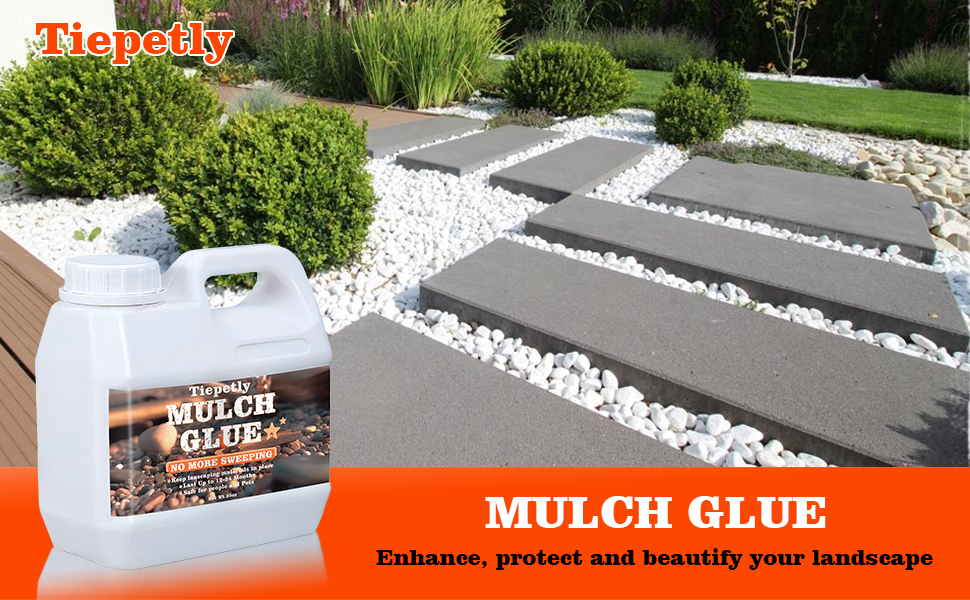Table of Contents
Introduction:
In the world of landscaping and gardening, mulch serves as a vital component for promoting plant health, conserving moisture, and enhancing the aesthetic appeal of outdoor spaces. However, traditional mulch application methods often face challenges such as displacement due to wind or rain. Enter mulch glue—a innovative solution designed to secure mulch in place, prevent erosion, and optimize the effectiveness of mulch for landscaping and garden projects. In this comprehensive guide, we explore the concept of mulch glue, its benefits, applications, and its role in sustainable landscaping practices.
Understanding Mulch Glue:

Mulch glue, also known as mulch adhesive or tackifier, is a specialized product formulated to bind mulch particles together and adhere them to the soil surface. Typically made from biodegradable polymers or natural ingredients, mulch glue forms a durable, water-resistant bond that helps to stabilize mulch and prevent it from shifting or washing away. By effectively anchoring mulch in place, mulch glue enhances its longevity, reduces the need for frequent replenishment, and promotes the overall health of plants and soil.
Benefits of Mulch Glue:
The use of mulch glue offers numerous benefits for landscaping and gardening projects, including:
Erosion Control: Mulch glue helps to prevent soil erosion by stabilizing mulch particles and minimizing runoff caused by wind or heavy rainfall.
Weed Suppression: By forming a protective barrier over the soil surface, mulch glue inhibits weed growth and reduces the need for herbicides or manual weeding.
Moisture Retention: Mulch glue enhances the water retention capabilities of mulch, reducing evaporation and helping to maintain optimal soil moisture levels for plant growth.
Enhanced Aesthetics: With mulch glue, landscapers can achieve a cleaner, more polished appearance in outdoor spaces, as mulch remains neatly in place without unsightly bare patches or scattered debris.
Applications of Mulch Glue:

Mulch glue can be applied in various landscaping and gardening scenarios, including:
Flower Beds and Borders: Use mulch glue to secure mulch around flower beds, shrubs, and garden borders, creating a tidy and well-defined edge.
Slopes and Embankments: Apply mulch glue on sloped or steep terrain to prevent mulch from washing away and minimize soil erosion.
Pathways and Walkways: Use mulch glue to stabilize mulch along pathways, walkways, and garden trails, providing a stable and slip-resistant surface.
Play Areas and Outdoor Spaces: Apply mulch glue in playgrounds, outdoor seating areas, and recreational spaces to ensure mulch remains in place and safe for use.
Sustainable Landscaping Practices:
In addition to its practical benefits, mulch glue plays a role in promoting sustainable landscaping practices. By reducing the need for frequent mulch replenishment, minimizing soil erosion, and conserving water, mulch glue contributes to the preservation of natural resources and the health of ecosystems. Furthermore, many mulch glue formulations are biodegradable and eco-friendly, further aligning with principles of sustainability and environmental stewardship.
Conclusion:
In conclusion, mulch glue offers a versatile and sustainable solution for enhancing landscaping and garden projects. By stabilizing mulch, preventing erosion, and promoting water conservation, mulch glue contributes to the health and vitality of outdoor spaces while reducing maintenance requirements and enhancing aesthetics. As landscaping professionals and gardeners increasingly prioritize sustainability and environmental responsibility, mulch glue emerges as a valuable tool for achieving these goals while maximizing the benefits of mulch in outdoor environments. Whether used in flower beds, pathways, or play areas, mulch glue represents a smart and innovative approach to landscaping that enhances both functionality and beauty in outdoor spaces.
For More Information Please Visit These Websites Craiyon And arturia

